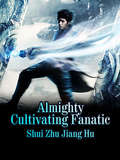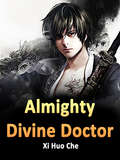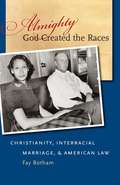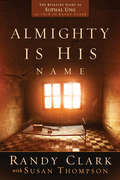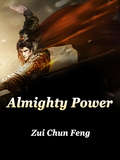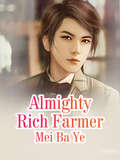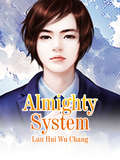- Table View
- List View
Almighty Cultivating Fanatic: Volume 4 (Volume 4 #4)
by Shui ZhujianghuThe universe was like a sleeve, moving at night. In the surging currents of history, Chen Yang was everywhere. He was once the great general who had pacified the world in ancient times, an extremely powerful subject! He used to be a Grand Scholar of the Shuangjie Painting Sect, but now he was branded as Wen Zheng! He used to be the true master of face-to-face ghost hunting, and his achievements were boundless!He had seen the vicissitudes of life, he had seen the alpine plains, and now that he had returned from the ninth reincarnation, he had merged into the body of a young man of modern times.
Almighty Cultivating Fanatic: Volume 5 (Volume 5 #5)
by Shui ZhujianghuThe universe was like a sleeve, moving at night. In the surging currents of history, Chen Yang was everywhere. He was once the great general who had pacified the world in ancient times, an extremely powerful subject! He used to be a Grand Scholar of the Shuangjie Painting Sect, but now he was branded as Wen Zheng! He used to be the true master of face-to-face ghost hunting, and his achievements were boundless!He had seen the vicissitudes of life, he had seen the alpine plains, and now that he had returned from the ninth reincarnation, he had merged into the body of a young man of modern times.
Almighty Cultivating Fanatic: Volume 6 (Volume 6 #6)
by Shui ZhujianghuThe universe was like a sleeve, moving at night. In the surging currents of history, Chen Yang was everywhere. He was once the great general who had pacified the world in ancient times, an extremely powerful subject! He used to be a Grand Scholar of the Shuangjie Painting Sect, but now he was branded as Wen Zheng! He used to be the true master of face-to-face ghost hunting, and his achievements were boundless!He had seen the vicissitudes of life, he had seen the alpine plains, and now that he had returned from the ninth reincarnation, he had merged into the body of a young man of modern times.
Almighty Divine Doctor: Volume 1 (Volume 1 #1)
by Xi HuoCheLearning medicine in the mountains is too boring. Come down the mountain and find your wife. Who knew that just as he reached the foot of the mountain, there were two beautiful girls who called him husband. Upon closer inspection, he had a cold illness! Sleep together. Don't hit, I'm telling the truth. With your extremely cold physique, you'll have to rely on my pure Yang body to 'heal' you. "Shame?" "Okay, then can you turn off the lights first?" And if the top quality Godly Doctor were to laugh at the beauty of the flower, the doctors would control the beauty of the masses!
Almighty Divine Doctor: Volume 10 (Volume 10 #10)
by Xi HuoCheLearning medicine in the mountains is too boring. Come down the mountain and find your wife. Who knew that just as he reached the foot of the mountain, there were two beautiful girls who called him husband. Upon closer inspection, he had a cold illness! Sleep together. Don't hit, I'm telling the truth. With your extremely cold physique, you'll have to rely on my pure Yang body to 'heal' you. "Shame?" "Okay, then can you turn off the lights first?" And if the top quality Godly Doctor were to laugh at the beauty of the flower, the doctors would control the beauty of the masses!
Almighty Divine Doctor: Volume 2 (Volume 2 #2)
by Xi HuoCheLearning medicine in the mountains is too boring. Come down the mountain and find your wife. Who knew that just as he reached the foot of the mountain, there were two beautiful girls who called him husband. Upon closer inspection, he had a cold illness! Sleep together. Don't hit, I'm telling the truth. With your extremely cold physique, you'll have to rely on my pure Yang body to 'heal' you. "Shame?" "Okay, then can you turn off the lights first?" And if the top quality Godly Doctor were to laugh at the beauty of the flower, the doctors would control the beauty of the masses!
Almighty Divine Doctor: Volume 3 (Volume 3 #3)
by Xi HuoCheLearning medicine in the mountains is too boring. Come down the mountain and find your wife. Who knew that just as he reached the foot of the mountain, there were two beautiful girls who called him husband. Upon closer inspection, he had a cold illness! Sleep together. Don't hit, I'm telling the truth. With your extremely cold physique, you'll have to rely on my pure Yang body to 'heal' you. "Shame?" "Okay, then can you turn off the lights first?" And if the top quality Godly Doctor were to laugh at the beauty of the flower, the doctors would control the beauty of the masses!
Almighty Divine Doctor: Volume 4 (Volume 4 #4)
by Xi HuoCheLearning medicine in the mountains is too boring. Come down the mountain and find your wife. Who knew that just as he reached the foot of the mountain, there were two beautiful girls who called him husband. Upon closer inspection, he had a cold illness! Sleep together. Don't hit, I'm telling the truth. With your extremely cold physique, you'll have to rely on my pure Yang body to 'heal' you. "Shame?" "Okay, then can you turn off the lights first?" And if the top quality Godly Doctor were to laugh at the beauty of the flower, the doctors would control the beauty of the masses!
Almighty Divine Doctor: Volume 5 (Volume 5 #5)
by Xi HuoCheLearning medicine in the mountains is too boring. Come down the mountain and find your wife. Who knew that just as he reached the foot of the mountain, there were two beautiful girls who called him husband. Upon closer inspection, he had a cold illness! Sleep together. Don't hit, I'm telling the truth. With your extremely cold physique, you'll have to rely on my pure Yang body to 'heal' you. "Shame?" "Okay, then can you turn off the lights first?" And if the top quality Godly Doctor were to laugh at the beauty of the flower, the doctors would control the beauty of the masses!
Almighty Divine Doctor: Volume 6 (Volume 6 #6)
by Xi HuoCheLearning medicine in the mountains is too boring. Come down the mountain and find your wife. Who knew that just as he reached the foot of the mountain, there were two beautiful girls who called him husband. Upon closer inspection, he had a cold illness! Sleep together. Don't hit, I'm telling the truth. With your extremely cold physique, you'll have to rely on my pure Yang body to 'heal' you. "Shame?" "Okay, then can you turn off the lights first?" And if the top quality Godly Doctor were to laugh at the beauty of the flower, the doctors would control the beauty of the masses!
Almighty Divine Doctor: Volume 7 (Volume 7 #7)
by Xi HuoCheLearning medicine in the mountains is too boring. Come down the mountain and find your wife. Who knew that just as he reached the foot of the mountain, there were two beautiful girls who called him husband. Upon closer inspection, he had a cold illness! Sleep together. Don't hit, I'm telling the truth. With your extremely cold physique, you'll have to rely on my pure Yang body to 'heal' you. "Shame?" "Okay, then can you turn off the lights first?" And if the top quality Godly Doctor were to laugh at the beauty of the flower, the doctors would control the beauty of the masses!
Almighty Divine Doctor: Volume 8 (Volume 8 #8)
by Xi HuoCheLearning medicine in the mountains is too boring. Come down the mountain and find your wife. Who knew that just as he reached the foot of the mountain, there were two beautiful girls who called him husband. Upon closer inspection, he had a cold illness! Sleep together. Don't hit, I'm telling the truth. With your extremely cold physique, you'll have to rely on my pure Yang body to 'heal' you. "Shame?" "Okay, then can you turn off the lights first?" And if the top quality Godly Doctor were to laugh at the beauty of the flower, the doctors would control the beauty of the masses!
Almighty Divine Doctor: Volume 9 (Volume 9 #9)
by Xi HuoCheLearning medicine in the mountains is too boring. Come down the mountain and find your wife. Who knew that just as he reached the foot of the mountain, there were two beautiful girls who called him husband. Upon closer inspection, he had a cold illness! Sleep together. Don't hit, I'm telling the truth. With your extremely cold physique, you'll have to rely on my pure Yang body to 'heal' you. "Shame?" "Okay, then can you turn off the lights first?" And if the top quality Godly Doctor were to laugh at the beauty of the flower, the doctors would control the beauty of the masses!
Almighty God Created the Races
by Fay BothamIn this fascinating cultural history of interracial marriage and its legal regulation in the United States, Fay Botham argues that religion--specifically, Protestant and Catholic beliefs about marriage and race--had a significant effect on legal decisions concerning miscegenation and marriage in the century following the Civil War. She contends that the white southern Protestant notion that God "dispersed" the races and the American Catholic emphasis on human unity and common origins point to ways that religion influenced the course of litigation and illuminate the religious bases for Christian racist and antiracist movements.
Almighty Is His Name: The Riveting Story of SoPhal Ung
by Randy ClarkAlmighty is His Name is the riveting story of God&’s hand of protection as missionary SoPhal Ung and his family fought for their lives in Cambodia. Although the Vietnamese invaded Cambodia in 1979, SoPhal started a house church, which grew from five members to six hundred in eight months. He was arrested for this &“illegal&” activity, imprisoned, severely beaten, and chained by hand and foot, losing seventy-five pounds in the terrible ordeal. God miraculously spared his life on numerous occasions. Later SoPhal fled with his wife and children to Thailand and spent ten years ministering to other Cambodian exiles. This page-turning narrative, recounted by Randy Clark founding director of Global Awakening, showcases an extraordinary kind of courage that was found in the heart of a man whose faith in Jesus Christ never wavered even in the face of unspeakable evil. SoPhal continues to train countless leaders, feed orphans, house and clothe the poor, and witness miracle upon miracle. For anyone seeking proof of God&’s greatness, this unforgettable true story will prove without a doubt that God is faithful.
Almighty Power: Volume 1 (Volume 1 #1)
by Zui ChunFeng"No, no …" "I'll just agree to marry you, I definitely won't marry you …" "How can you be like this? "You said that you truly like me, but to do such a thing to me, you will definitely die..." "Liu Lin, I beg you, don't! I agree to marry you …"
Almighty Rich Farmer: Volume 1 (Volume 1 #1)
by Mei BaYeThe village boy originally had no ambition. However, after being humiliated again and again by the village tyrant, he was forced to rise up and walk the path of village officials. This so-called blessed person was blessed by the heavens. With the help of the top-grade fox immortal, he could win every battle.
Almighty Rich Farmer: Volume 2 (Volume 2 #2)
by Mei BaYeThe village boy originally had no ambition. However, after being humiliated again and again by the village tyrant, he was forced to rise up and walk the path of village officials. This so-called blessed person was blessed by the heavens. With the help of the top-grade fox immortal, he could win every battle.
Almighty Rich Farmer: Volume 3 (Volume 3 #3)
by Mei BaYeThe village boy originally had no ambition. However, after being humiliated again and again by the village tyrant, he was forced to rise up and walk the path of village officials. This so-called blessed person was blessed by the heavens. With the help of the top-grade fox immortal, he could win every battle.
Almighty Rich Farmer: Volume 4 (Volume 4 #4)
by Mei BaYeThe village boy originally had no ambition. However, after being humiliated again and again by the village tyrant, he was forced to rise up and walk the path of village officials. This so-called blessed person was blessed by the heavens. With the help of the top-grade fox immortal, he could win every battle.
Almighty Soldier King: Volume 1 (Volume 1 #1)
by Fu ShengLove hate parting make a pair of fate bitter lovers after a few twists and turns they can get through the difficulties together plot he can overcome difficulties everything really as he wishes is it really that simple it seems that everything is a game in a game so their love can be verified they can hold hands is it really as easy as he imagined that there would be something hidden behind the plot will it really end this way perhaps everything is just the beginning but he knew that whatever the difficulties and crushed even to the heavens and the earth he will not have the slightest fear which he it is a let a person not afraid everything man obsessed by his story all of the answer to a riddle all in this book together let us explore the secret of the unknown
Almighty System: Volume 1 (Volume 1 #1)
by Lun HuiWuChangThere was nothing Heaven Descending Divine Cauldron couldn't do. Alchemy, treasure crafting, synthesis, roasting … After obtaining this miraculous Heavenly Cauldron, Du Dapeng was almighty and omnipotent. Not only did he possess superb strength, he even refined a cute pet to curry favor with the goddess … "Sigh... [Previous Chapter] [Table of Contents] [Next Chapter]
Almighty System: Volume 2 (Volume 2 #2)
by Lun HuiWuChangThere was nothing Heaven Descending Divine Cauldron couldn't do. Alchemy, treasure crafting, synthesis, roasting … After obtaining this miraculous Heavenly Cauldron, Du Dapeng was almighty and omnipotent. Not only did he possess superb strength, he even refined a cute pet to curry favor with the goddess … "Sigh... [Previous Chapter] [Table of Contents] [Next Chapter]
Almighty System: Volume 3 (Volume 3 #3)
by Lun HuiWuChangThere was nothing Heaven Descending Divine Cauldron couldn't do. Alchemy, treasure crafting, synthesis, roasting … After obtaining this miraculous Heavenly Cauldron, Du Dapeng was almighty and omnipotent. Not only did he possess superb strength, he even refined a cute pet to curry favor with the goddess … "Sigh... [Previous Chapter] [Table of Contents] [Next Chapter]
Almighty System: Volume 4 (Volume 4 #4)
by Lun HuiWuChangThere was nothing Heaven Descending Divine Cauldron couldn't do. Alchemy, treasure crafting, synthesis, roasting … After obtaining this miraculous Heavenly Cauldron, Du Dapeng was almighty and omnipotent. Not only did he possess superb strength, he even refined a cute pet to curry favor with the goddess … "Sigh... [Previous Chapter] [Table of Contents] [Next Chapter]
